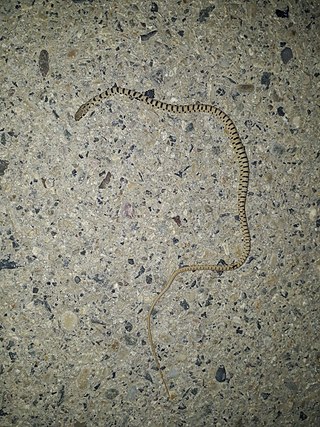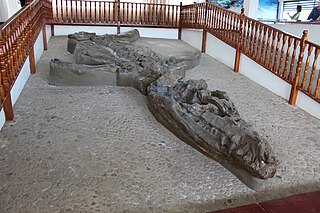
Colubridae is a family of snakes. With 249 genera, it is the largest snake family. The earliest fossil species of the family date back to the Late Eocene epoch, with earlier origins suspected. Colubrid snakes are found on every continent except Antarctica.

A snake skeleton consists primarily of the skull, vertebrae, and ribs, with only vestigial remnants of the limbs.

Hardwicke's rat snake, also known commonly as the glossy-bellied racer, Gray's rat snake, and the spotted bellied snake, is a species of snake in the family Colubridae. The species is native to Asia. There are three recognized subspecies.

Lytorhynchus paradoxus, commonly known as the Sindh awl-headed snake and the Sind longnose sand snake, is a species of snake in the family Colubridae. The species is native to the desert areas of Pakistan and India (Rajasthan).

Trachischium is a genus of snakes, known commonly as slender snakes or worm-eating snakes, in the subfamily Natricinae of the family Colubridae. The genus is endemic to Asia.

The Colubrinae are a subfamily of snakes within the family Colubridae. It includes numerous genera, and although taxonomic sources often disagree on the exact number, the Reptile Database lists 717 species in 92 genera as of September 2019. It is the second largest subfamily of colubrids, after Dipsadinae. Many of the most commonly known snakes are members of this subfamily, including rat snakes, king snakes, milk snakes, vine snakes, and indigo snakes.
Clidastes is an extinct genus of marine lizard belonging to the mosasaur family. It is classified as part of the Mosasaurinae subfamily, alongside genera like Mosasaurus and Prognathodon. Clidastes is known from deposits ranging in age from the Coniacian to the early Campanian in the United States.

The Caspian whipsnake also known as the large whipsnake, is a common species of whipsnake found in the Balkans and parts of Eastern Europe.

Platyceps karelini, the spotted desert racer, is a species of snake in the family Colubridae. The species is endemic to Asia.
The western keeled snake is a species of snake in the family Pseudaspididae. It is native to western Namibia, southwestern Angola, and southwestern Zambia, and is the only member of the genus Pythonodipsas.

Monquirasaurus is an extinct genus of giant short-necked pliosaurs who lived during the Early Cretaceous (Aptian) in what is now Colombia. One species is known, M. boyacensis, described in 2021 from an almost complete fossil skeleton, discovered in 1977 in the town of Villa de Leyva, located in Boyacá. Published descriptions of the holotype specimen estimate that it should reach a total size approaching 8 m (26 ft) in length, making Monquirasaurus a large representative of the pliosaurids.










